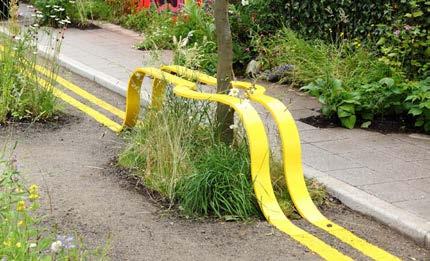
3 minute read
Creating street space out of adversity
Oliver Goodhall
In the context of austerity, our public open spaces have come under increasing stresses – diminishing maintenance budgets have led to asset transfers and pressure to generate income. But now, in the context of COVID-19, we see a momentary – seemingly unanimous – shift towards valuing public sector strength in all types of critical infrastructure. Access to open space is included alongside the same fundamental needs as our health service and financial security through to calls for implementing a Universal Basic Income.
Countries around the world are adjusting to safeguarding these fundamental needs in unprecedented times. Societies are reassessing their core values, and cities around the world are reorganising public spaces to tackle the COVID-19 crisis. What of this will stick with us in a postpandemic world?
Clearly right now, the need for and value of our open spaces of all types is more acute. More than 60% of London is ‘open land’, yet only 6% is parks and public gardens. How can we maximise the wellbeing and health benefits of the other 54% – the roads, sports facilities and left-over space? It’s not just access to green space and parks that is vital for public health. Our streets provide the real opportunity for locking-in permanent change.

The Edible Bus Stop’s approach to streetscape.
© Will Sandy
On 16th April 2020, the Department for Transport has loosened its rules to allow councils to easily make roads car-free, widen footways, or create temporary cycle lanes. The lengthy processes of Traffic Regulation Orders (TROs) has been temporarily circumvented to allow quick implementation. Brighton has acted fast. It joins Berlin, Bogotá, Budapest, Boston and others in enacting changes.
The Kreuzberg district of Berlin has trialled temporary ‘pop-up’ cycle lanes. The Colombian capital of Bogotá is creating 76km of temporary cycle lanes, with 22km of these new lanes converted from road space overnight on 17th March. In New Zealand the Transport Minister has invited cities to apply for 90% funding to widen footways and create temporary cycle infrastructure that can be put in place within hours and days.
Even in car-dominated cities in the US, perhaps the car is no longer king. Starting Saturday April 11, Oakland Mayor Libby Schaaf and the Oakland Department of Transportation have closed approximately 10% of the city’s roads to vehicles and designated 120km of neighbourhood streets to cycling and walking.
We have seen cities pivot at key points of crisis before. After the Tokyo 2011 earthquake hit the metropolitan area, train and subways stopped out of fear of aftershocks. Commuters switched to cycling instead . Closer to home, researchers at the London School of Economics found that the February 2014 London Underground staff strikes forced many commuters to experiment and find alternative routes. Behaviours can change. One in 20 stuck with their new routes after the strike was over .
I would like changes to streets to become permanent. They should:
– Be important public spaces where people want to spend time
– Enable extra journeys on foot and by bike
– Become places where we feel empowered to act to reallocate space for pedestrians, for culture, play, wellbeing and everyday activity
– Be egalitarian places where all people can come together
– Feature everyday infrastructure that can be readily closed, changed and adapted to suit neighbourhood needs
– Become common places that are universally adapted to respond to the climate emergency
Many are looking for silver linings in this terrible crisis. If we can use our new-found values to further long-term health and wellbeing, supported by the everyday infrastructure of our cities, that could certainly be one.
Oliver Goodhall is a co-founding Partner of We Made That, an architecture and urbanism practice based in London. The practice includes architects, urban designers, planners and urban researchers. They only work for public clients and are guided by a strong civic ethos.










